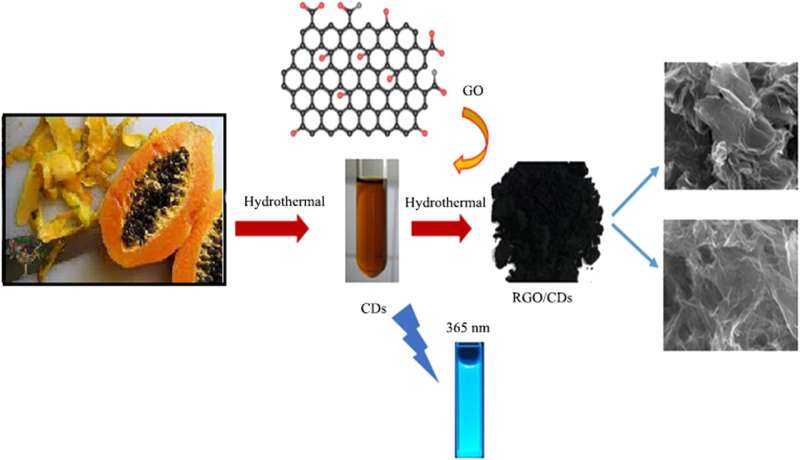
In a significant leap towards sustainable environmental management and antimicrobial strategies, a team of international researchers has successfully synthesized a fluorescent carbon dot (CD) and reduced graphene oxide (RGO) nanocomposite from papaya peel waste. The study, published in the Journal of Bioresources and Bioproducts, details a one-step hydrothermal method to fabricate the nanocomposite, which was then characterized using various spectroscopic and microscopic techniques.
The research was driven by the need to address water contamination and environmental pollution caused by the extensive use of organic compounds, particularly in the agricultural industry. The textile industry, which consumes up to 50% of the total dyes produced, contributes significantly to this pollution. The study aimed to develop a photocatalyst capable of degrading these toxic compounds under solar irradiation.
The synthesized RGO/CD (RC) nanocomposites exhibited exceptional photocatalytic activity, with the highest degradation efficiency of 87% achieved in the composite containing a 2:1 mass ratio of RGO to CDs. The RGO sheets in the nanocomposite facilitated the transfer and separation of photoinduced electrons, preventing their recombination and enhancing the photocatalytic performance.
In addition to its photocatalytic prowess, the nanocomposite also displayed impressive antibacterial activity against Bacillus subtilis (Gram-positive) and Pseudomonas aeruginosa (Gram-negative) bacteria. The largest inhibition zone was observed in the nanocomposite tested against Gram-positive strains, indicating its potential as a broad-spectrum antimicrobial agent.
The study’s findings highlight the innovative use of agricultural waste in the development of materials with multifaceted applications. The nanocomposite’s dual functionality as both a photocatalyst and an antimicrobial agent underscores its potential in addressing environmental and public health challenges. The research also emphasizes the importance of sustainable and eco-friendly production methods, aligning with global efforts to reduce waste and promote green chemistry.
The authors suggest that the synergistic effect of RGO and CDs in the nanocomposite enhances its photocatalytic and antibacterial performance, making it a promising material for treating chronic infections and device-associated diseases caused by biofilm-producing multidrug-resistant bacteria.
More information:
Hesam Salimi Shahraki et al, Papaya peel waste carbon dots/reduced graphene oxide nanocomposite: From photocatalytic decomposition of methylene blue to antimicrobial activity, Journal of Bioresources and Bioproducts (2023). DOI: 10.1016/j.jobab.2023.01.009
Provided by
Journal of Bioresources and Bioproducts
Citation:
New nanocomposite from papaya peel waste exhibits promising photocatalytic and antibacterial activity (2024, April 23)
retrieved 23 April 2024
from https://phys.org/news/2024-04-nanocomposite-papaya-photocatalytic-antibacterial.html
This document is subject to copyright. Apart from any fair dealing for the purpose of private study or research, no
part may be reproduced without the written permission. The content is provided for information purposes only.
